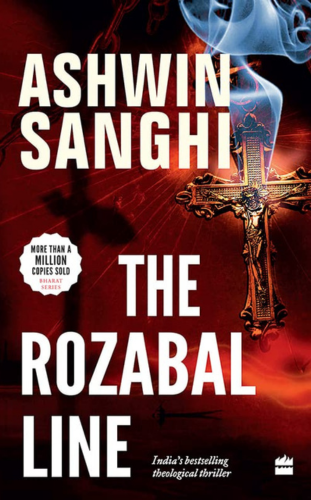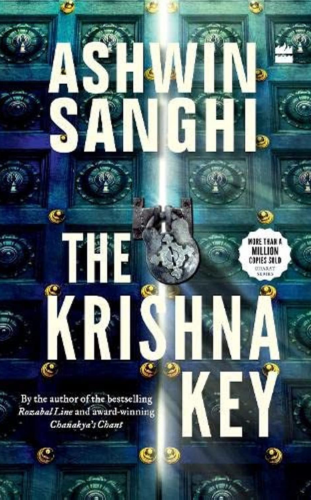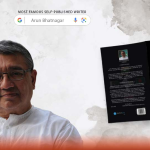Ashwin Sanghi, a luminary in the world of Indian literature, has cast an enchanting spell on readers with his enthralling works in the thriller and historical fiction genres. Born on January 25, 1969, amidst the vibrant tapestry of Mumbai, India, Sanghi has emerged as a towering figure, celebrated for his extraordinary storytelling prowess and the riveting tales he weaves.
Read: Learn everything about Technical Writing & What does an Technical Author do?
Deeply rooted in the realms of business and finance, Sanghi embarked on a journey of intellectual growth, obtaining an MBA from the prestigious Yale School of Management. Drawn to the allure of his family’s business, he returned to his homeland, ready to carve his path. Yet, destiny had other plans in store, tugging at the strings of his heart, beckoning him to embark on a remarkable literary odyssey.
In 2007, Sanghi unveiled his literary debut, “The Rozabal Line,” a work that would reverberate through the corridors of literature. “The Rozabal Line” is the debut novel by Ashwin Sanghi, published in 2007. This gripping thriller explores the enigmatic concept of Jesus Christ’s survival after the crucifixion and his alleged journey to India. Blending elements of history, religion, and conspiracy, Sanghi weaves a tale that captivates readers with its intricate plot and thought-provoking themes.
The Rozabal Line a Novel by Author Ashwin Sanghi
The story revolves around a diverse cast of characters whose lives intersect in unexpected ways. The narrative begins with a series of bombings in various cities around the world, triggering a global manhunt for the perpetrators. As the investigation unfolds, a parallel storyline takes the reader back in time to explore the life of a mysterious character known as “The Teacher.” This enigmatic figure possesses knowledge that challenges traditional beliefs about Jesus Christ and his final fate.
Sanghi skillfully interweaves multiple narratives, blending elements of Christianity, Hinduism, and Islam, as well as historical events and conspiracy theories. The book delves into the complex relationships between religion, faith, and the search for spiritual truth. As the characters embark on a journey filled with danger and intrigue, they encounter ancient manuscripts, secret societies, and hidden truths that have the power to shake the foundations of established belief systems.
“The Rozabal Line” takes its name from the Rozabal Shrine, a real-life tomb located in Kashmir, India, which some speculate to be the final resting place of Jesus Christ. This intriguing premise forms the backdrop for the novel, serving as a catalyst for the exploration of profound theological questions and the clash of religious ideologies.
Sanghi’s meticulous research is evident throughout the book, as he seamlessly integrates historical facts and religious texts into the fictional narrative. This attention to detail adds an air of authenticity to the story, blurring the lines between fact and fiction and leaving readers contemplating the boundaries of belief and the mysteries of human history.
“The Rozabal Line” garnered significant attention upon its release, captivating readers with its unique blend of suspense, mythology, and historical intrigue. The novel’s success established Ashwin Sanghi as a prominent voice in Indian literature, known for his ability to craft compelling narratives that merge the ancient and the contemporary.
Undeterred by the weight of his own success, Sanghi pressed forward, penning a succession of masterpieces that further immortalized his name. In 2010, he unleashed “Chanakya’s Chant,” a tour de force that seamlessly entwined historical chronicles and contemporary suspense. “Chanakya’s Chant” is a gripping historical fiction novel by Ashwin Sanghi, published in 2010. The book skillfully weaves together two parallel narratives set in different time periods, exploring the life and strategies of the ancient Indian political strategist Chanakya and their impact on modern-day politics.
The novel unfolds through alternating chapters that follow the lives of two protagonists. The first storyline takes place in ancient India during the fourth century BCE and revolves around Chanakya, also known as Kautilya or Vishnugupta. Chanakya, a brilliant strategist and advisor, sets out on a mission to unite a fragmented nation and establish a strong empire. His journey is fraught with political intrigue, betrayals, and the pursuit of power.
In the contemporary storyline, set in modern-day India, we meet Pandit Gangasagar Mishra, a shrewd and ambitious Brahmin with a deep understanding of politics. Mishra idolizes Chanakya and seeks to replicate his mentor’s strategies to rise to power in the political landscape of India. As Mishra maneuvers through the complex world of politics, he employs Chanakya’s ancient wisdom and teachings to shape his own destiny.
Sanghi skillfully interconnects the two narratives, drawing parallels between the ancient and modern characters, their motivations, and the strategies they employ. The novel explores themes of power, ambition, manipulation, and the intricate workings of the political realm.
Through meticulous research and attention to historical detail, Sanghi brings the character of Chanakya to life. Drawing from ancient Indian texts such as the Arthashastra, he showcases Chanakya’s strategic genius and his ability to manipulate events to achieve his goals. The author’s portrayal of Chanakya is both captivating and nuanced, offering readers a glimpse into the mind of a visionary leader.
“Chanakya’s Chant” not only provides a thrilling narrative but also offers insightful commentary on contemporary politics and the nature of power. It explores the lengths to which individuals are willing to go to attain and retain power, highlighting the timeless relevance of Chanakya’s teachings in navigating the treacherous waters of politics.
The novel’s popularity lies in Sanghi’s ability to seamlessly blend historical facts, political intrigue, and fictional storytelling. The complex web of alliances, betrayals, and power struggles keeps readers engrossed as they eagerly turn each page to uncover the fate of the characters and the impact of their actions.
“The Krishna Key” (2012), another jewel in Sanghi’s literary crown, delved into the annals of mythology and history, fusing them with an electrifying contemporary tale. “The Krishna Key” is an enthralling thriller novel written by Ashwin Sanghi and published in 2012. Blending elements of mythology, history, and suspense, the book takes readers on a captivating journey to unravel the secrets of an ancient artifact and its connection to Lord Krishna.
The story revolves around Ravi Mohan Saini, a historian and professor at St. Stephen’s College in Delhi. When a close friend and renowned archaeologist is found murdered, Saini becomes embroiled in a dangerous quest to clear his friend’s name and uncover the truth behind the crime.
As Saini delves deeper into the investigation, he discovers a startling link between the murder and an ancient seal believed to be the key to Lord Krishna’s most prized possession. The seal, known as the “Krishna Key,” holds the potential to unlock a hidden secret that could challenge established religious beliefs and reshape history.
The Krishna Key by Author Ashwin Sanghi
Guided by clues from ancient texts and scriptures, Saini races against time to decipher the cryptic messages and solve the riddles that lead to the Krishna Key. Along the way, he encounters a secret society known as the “Navnirman Sene,” which will stop at nothing to possess the Krishna Key and use its power for their own nefarious purposes.
Sanghi skillfully weaves together historical events, mythological legends, and fictional elements to create a gripping narrative. The novel seamlessly blends fact and fiction, blurring the lines between ancient history and contemporary suspense. The author’s meticulous research and attention to detail bring authenticity to the story, immersing readers in a world of ancient secrets and modern-day conspiracies.
“The Krishna Key” not only explores the mystery surrounding the artifact but also delves into the deeper philosophical and spiritual aspects associated with Lord Krishna. Sanghi delves into the symbolism and teachings of Krishna, offering thought-provoking insights into the enigmatic persona of one of Hindu mythology’s most revered figures.
The book’s fast-paced plot, filled with unexpected twists and turns, keeps readers on the edge of their seats. As Saini races against adversaries and uncovers hidden truths, the suspense intensifies, creating a sense of urgency and anticipation.
In 2016, Sanghi unveiled “The Sialkot Saga,” an opus that traversed the realms of business, power, and destiny. “The Sialkot Saga” is a gripping historical thriller novel written by Ashwin Sanghi and published in 2016. Set against the backdrop of India’s tumultuous history and the world of business and politics, the book weaves together a tale of ambition, power, and the price one pays for success.
The story follows two protagonists, Arvind and Arbaaz, whose lives intertwine in unexpected ways. Arvind grows up in the bustling streets of Mumbai, while Arbaaz hails from Sialkot, a city in present-day Pakistan. Despite their disparate backgrounds, both characters are driven by a burning desire to rise above their circumstances and achieve greatness.
Arvind, a street-smart young man, becomes immersed in the world of business and quickly learns the intricacies of the trade. Through sheer determination and cunning, he climbs the corporate ladder, amassing wealth and influence along the way. However, his success comes at a steep price as he becomes entangled in a web of power struggles, deceit, and betrayal.
The Sialkot Saga by Author Ashwin Sanghi
Arbaaz, on the other hand, dreams of becoming a crime lord and rules the underworld with an iron fist. His journey takes him from the mean streets of Sialkot to the criminal underworld of Mumbai. As he builds his empire, he becomes a force to be reckoned with, but his thirst for power threatens to consume him.
The narrative of “The Sialkot Saga” spans several decades, offering a panoramic view of India’s history from the Partition era to the present day. Through the lives of the two protagonists, the book explores themes of ambition, morality, loyalty, and the consequences of one’s choices.
Sanghi skillfully integrates historical events, such as the Partition of India, the Emergency, and economic reforms, into the fabric of the story. These events serve as a backdrop to the characters’ journeys, highlighting the impact of politics and societal changes on their lives.
“The Sialkot Saga” is a masterful blend of fact and fiction, with Sanghi’s meticulous research lending authenticity to the historical elements of the narrative. The author seamlessly combines real-world events with imaginative storytelling, creating a narrative that is both educational and entertaining.
The book’s strength lies in its complex characters and their moral dilemmas. Arvind and Arbaaz, driven by their ambitions, find themselves navigating a world where lines between right and wrong blur. Their choices have far-reaching consequences, and their paths cross in surprising and dramatic ways, leading to a gripping climax that will keep readers hooked until the very end.
Sanghi’s writing style is characterized by a fast-paced narrative, intricate plot twists, and well-developed characters. He excels at keeping readers engaged and guessing, as the story takes unexpected turns and revelations come to light. The author’s ability to create a sense of suspense and anticipation adds to the book’s appeal, making it difficult to put down.
“Keepers of the Kalachakra” (2018) marked yet another milestone in Sanghi’s extraordinary career. “Keepers of the Kalachakra” is a thrilling and thought-provoking novel written by Ashwin Sanghi and published in 2018. As with his previous works, Sanghi skillfully combines history, mythology, and suspense to create a captivating narrative that explores ancient secrets, conspiracy theories, and the clash between science and spirituality.
The story revolves around Vidyut Shastri, a brilliant scientist who becomes entangled in a web of intrigue and danger. Vidyut is drawn into a world where ancient prophecies, secret organizations, and hidden knowledge hold the key to unlocking the mysteries of the universe.
At the heart of the novel is the Kalachakra, an ancient Buddhist text that contains profound knowledge about time and consciousness. The Kalachakra is said to possess the power to alter the course of human evolution and hold the key to enlightenment. As various factions seek to possess this sacred knowledge, Vidyut finds himself caught in a race against time to protect it and prevent its misuse.
As Vidyut delves deeper into the secrets of the Kalachakra, he discovers a dark conspiracy that spans centuries and threatens the fabric of humanity. Along his journey, he encounters a diverse cast of characters, each with their own agendas and motivations. From a Tibetan Buddhist monk to a mysterious woman with a troubled past, the characters add depth and complexity to the narrative, keeping readers guessing and engaged.
Keepers of the Kalachakra by Author Ashwin Sanghi
Sanghi’s meticulous research and attention to detail shine through in “Keepers of the Kalachakra.” The book is replete with historical references, scientific theories, and philosophical insights, all seamlessly woven into the fabric of the story. The author’s ability to blend fact and fiction creates a compelling narrative that stimulates the reader’s imagination while offering thought-provoking reflections on the nature of reality, consciousness, and the pursuit of knowledge.
The novel explores themes of power, spirituality, and the ethical implications of scientific advancements. It raises profound questions about the boundaries of human understanding, the potential consequences of tampering with ancient wisdom, and the delicate balance between progress and preservation. Through its intricate plot and well-developed characters, “Keepers of the Kalachakra” invites readers to contemplate the complexities of the universe and their place within it.
Sanghi’s writing style is marked by a fast pace, tight suspense, and skillful storytelling. The narrative unfolds through multiple perspectives, alternating between past and present, myth and reality, gradually revealing the connections and intricacies of the plot. The author’s ability to maintain tension and surprise keeps readers engrossed and eager to uncover the truth.
Conclusion
Sanghi’s writing style, a delicate fusion of meticulous research and boundless creativity, has garnered him a devoted following. With each stroke of his pen, he unveils a meticulously constructed world, where fact and fiction harmoniously intertwining, blurring the boundaries between reality and imagination. His narrative prowess lies not only in his captivating plots but also in his ability to breathe life into his characters, endowing them with depth, complexity, and relatability.
Beyond the realm of his individual works, Ashwin Sanghi has left an indelible mark on the literary landscape of India. He stands as a pioneer, heralding the genre of historical fiction and inspiring a new generation of writers to delve into the rich tapestry of India’s past. His relentless pursuit of excellence has propelled his books to the top of bestseller lists, captivating readers from diverse backgrounds and transcending cultural boundaries.
Sanghi’s impact extends beyond the written word. As an astute entrepreneur and philanthropist, he has made significant contributions to society. While his writing sparks the imagination, his commitment to promoting literacy and education ignites a brighter future. He actively supports initiatives aimed at improving access to books and education for underprivileged children, recognizing the transformative power of knowledge and the importance of nurturing young minds.
In the grand tapestry of Indian literature, Ashwin Sanghi stands as a luminary, his words woven into the fabric of our collective consciousness. With each stroke of his pen, he beckons readers into a realm where history, mythology, and suspense converge. He challenges us to question the boundaries of what we know and to venture into the unexplored recesses of our minds. Through his creative genius, Sanghi paints a vivid portrait of India’s rich heritage, captivating readers with tales that resonate long after the final page is turned.
As we embark on this literary odyssey with Ashwin Sanghi, we are reminded that the power of storytelling lies not only in its ability to entertain but also in its capacity to illuminate the human experience. With his boundless imagination and unwavering dedication to his craft, Sanghi continues to leave an indelible mark on the literary world, captivating hearts, and minds with his unique blend of history, myth, and intrigue.
In the realm of Ashwin Sanghi’s narratives, we are transported to a realm where the past collides with the present, where ancient mysteries unfurl amidst the complexities of modern life. It is a realm where imagination reigns supreme, and the power of words has the ability to shape destinies. Through his extraordinary literary prowess, Sanghi has firmly established himself as an icon of Indian literature, and his legacy will continue to inspire generations of readers and writers alike.



















